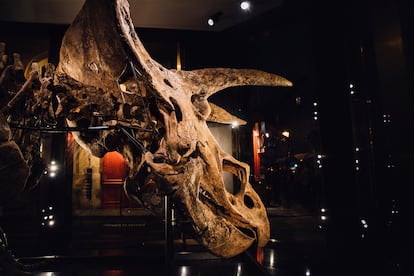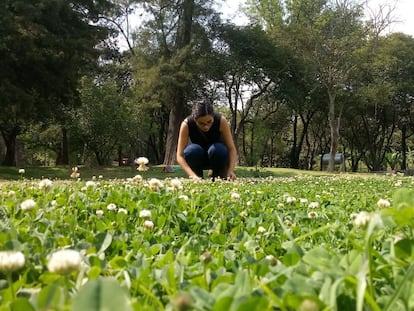Study: ‘Big John,’ world’s largest triceratops, fought with others of his kind
New research into an injury on the dinosaur’s neck frill suggests that physical combat was part of their lives


“Big John” is the name given to the largest known skeleton of the Triceratops horridus dinosaur. The skeleton was discovered in 2014 by the commercial paleontologist Walter W. Stein during an excavation on a ranch in South Dakota, in an area known as the Hell Creek geological formation. Last October it sold at auction for $7.7 million (€6.5 million) But last spring, while it was being restored prior to the auction, geologist Flavio Bacchia noticed something curious: a large hole in its armored neck frill. He asked Ruggero D’Anastasio, a paleopathologist at D’Annunzio University of Chieti–Pescara in Italy, for his opinion.
Right from the start, it was believed to be a combat injury, and this was confirmed by histological and chemical analysis of the bones: the hole was due to a traumatic injury that happened at least six months before the death of Big John. The bone was healing at the time of his death. The research, published on Thursday in Scientific Reports, concludes that the injury was the result of a fight with another triceratops, which would confirm that the dinosaur locked horns with its own kind.
The study found that the bone surface around this opening was irregular and overlaid with plaque-like deposits, which could be a sign of inflammation. The samples taken at the edge of the hole also revealed that the surrounding bone tissue was porous, with many more blood vessels compared to tissue further away, indicating that the bone was recently formed. This indicates that the opening was made before the dinosaur’s death and was not an abnormality.
D’Anastasio, who is one of the authors of the paper, says that this study not only confirms that triceratops fought with one another, it also reveals more information about the behavior of dinosaurs of that era. But in his opinion, the most important conclusion is the fact that certain physiological processes in some dinosaur bones appear to be similar to what is observed in mammals, including humans.
The researcher also points out that this is the first time that an injury, in particular a traumatic one, has been diagnosed thanks to histological analysis, which is the study of tissues and cells. In previous studies, these types of injuries were described based on the appearance of the bone, such as cracks around the wound, for example. This new alternative allows researchers to understand the nature of the opening, and whether or not it is the result of a traumatic injury.
Researchers believe that Big John was attacked from behind, with the rival first puncturing the neck frill and then rising up, giving the wound its keyhole shape. The triceratops has a large neck frill, two suborbital horns and another, small horn on their nose. According to the study, these features, as well as serving as distinguishing and recognition elements, also helped protect the cervical region of the skill from possible blows from rivals.
This idea is supported by a 2019 paper published in the science journal Plos One, which concluded that the horns and the frill of Triceratops were “display structures” or “weapons” against predators and members of its own kind. Luis Alcalá, a paleontologist and director of the Science Park in Granada, in southern Spain, says the researchers have presented a “sleek” argument to confirm this hypothesis.
Big John lived 66 million years ago. In total, 200 of its bones and 75% of its skull were recovered. While the skeleton was initially valued at between €1.2 and €1.5 million, it ended up selling for €6.65 million, according to the Italian auction house. It is not the only dinosaur fossil to be put up for auction. In 2020, a Tyrannosaurus rex known as “Stan” was sold for nearly $32 million (€30 million), according to the company in charge of the sale. This fossil was discovered nearly 30 years ago by Stan Sacriston, an amateur, who is the namesake of the dinosaur.
Tu suscripción se está usando en otro dispositivo
¿Quieres añadir otro usuario a tu suscripción?
Si continúas leyendo en este dispositivo, no se podrá leer en el otro.
FlechaTu suscripción se está usando en otro dispositivo y solo puedes acceder a EL PAÍS desde un dispositivo a la vez.
Si quieres compartir tu cuenta, cambia tu suscripción a la modalidad Premium, así podrás añadir otro usuario. Cada uno accederá con su propia cuenta de email, lo que os permitirá personalizar vuestra experiencia en EL PAÍS.
¿Tienes una suscripción de empresa? Accede aquí para contratar más cuentas.
En el caso de no saber quién está usando tu cuenta, te recomendamos cambiar tu contraseña aquí.
Si decides continuar compartiendo tu cuenta, este mensaje se mostrará en tu dispositivo y en el de la otra persona que está usando tu cuenta de forma indefinida, afectando a tu experiencia de lectura. Puedes consultar aquí los términos y condiciones de la suscripción digital.
More information
Últimas noticias
Most viewed
- Reinhard Genzel, Nobel laureate in physics: ‘One-minute videos will never give you the truth’
- Oona Chaplin: ‘I told James Cameron that I was living in a treehouse and starting a permaculture project with a friend’
- Pablo Escobar’s hippos: A serious environmental problem, 40 years on
- Why we lost the habit of sleeping in two segments and how that changed our sense of time
- Chevy Chase, the beloved comedian who was a monster off camera: ‘Not everyone hated him, just the people who’ve worked with him’










































